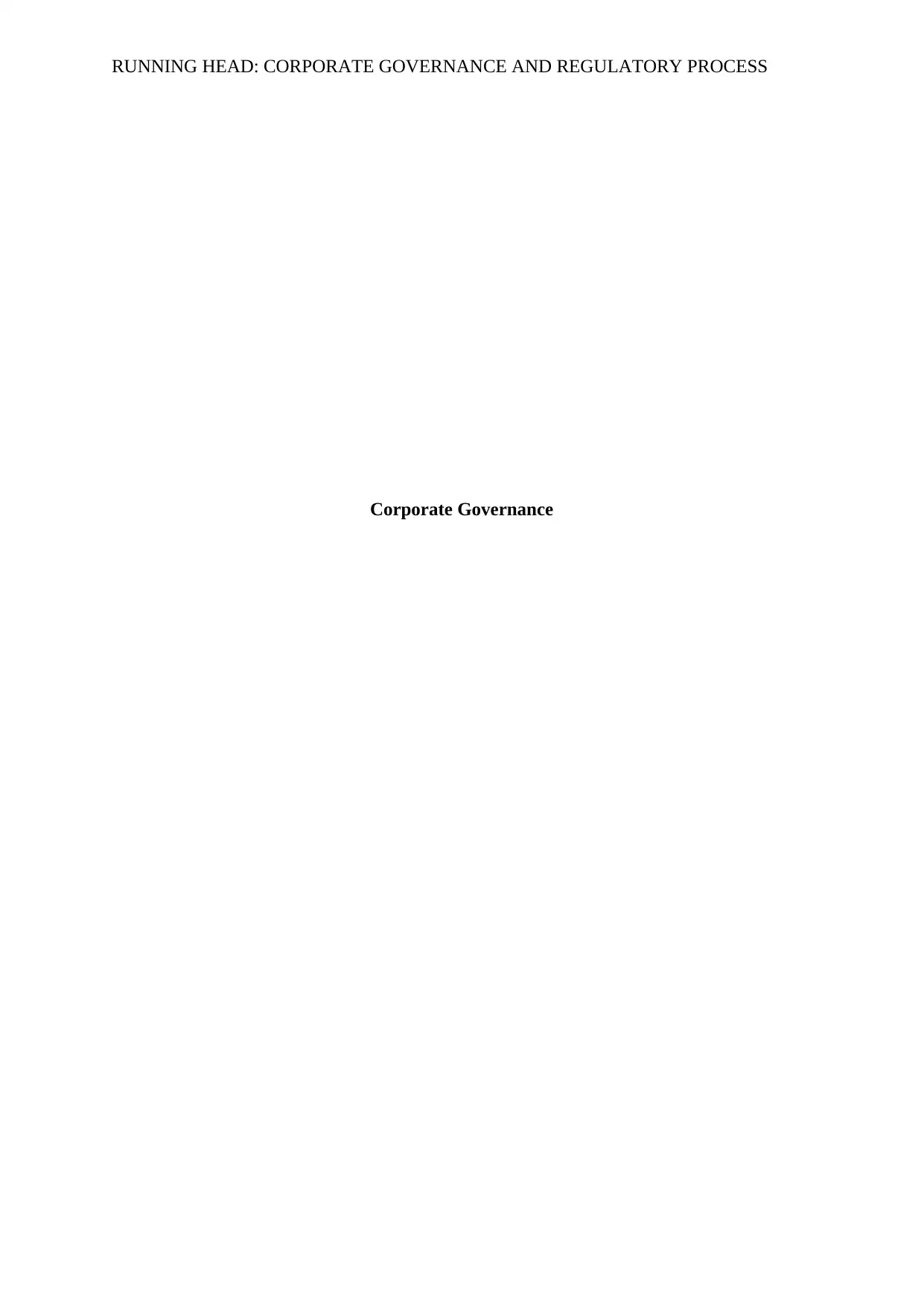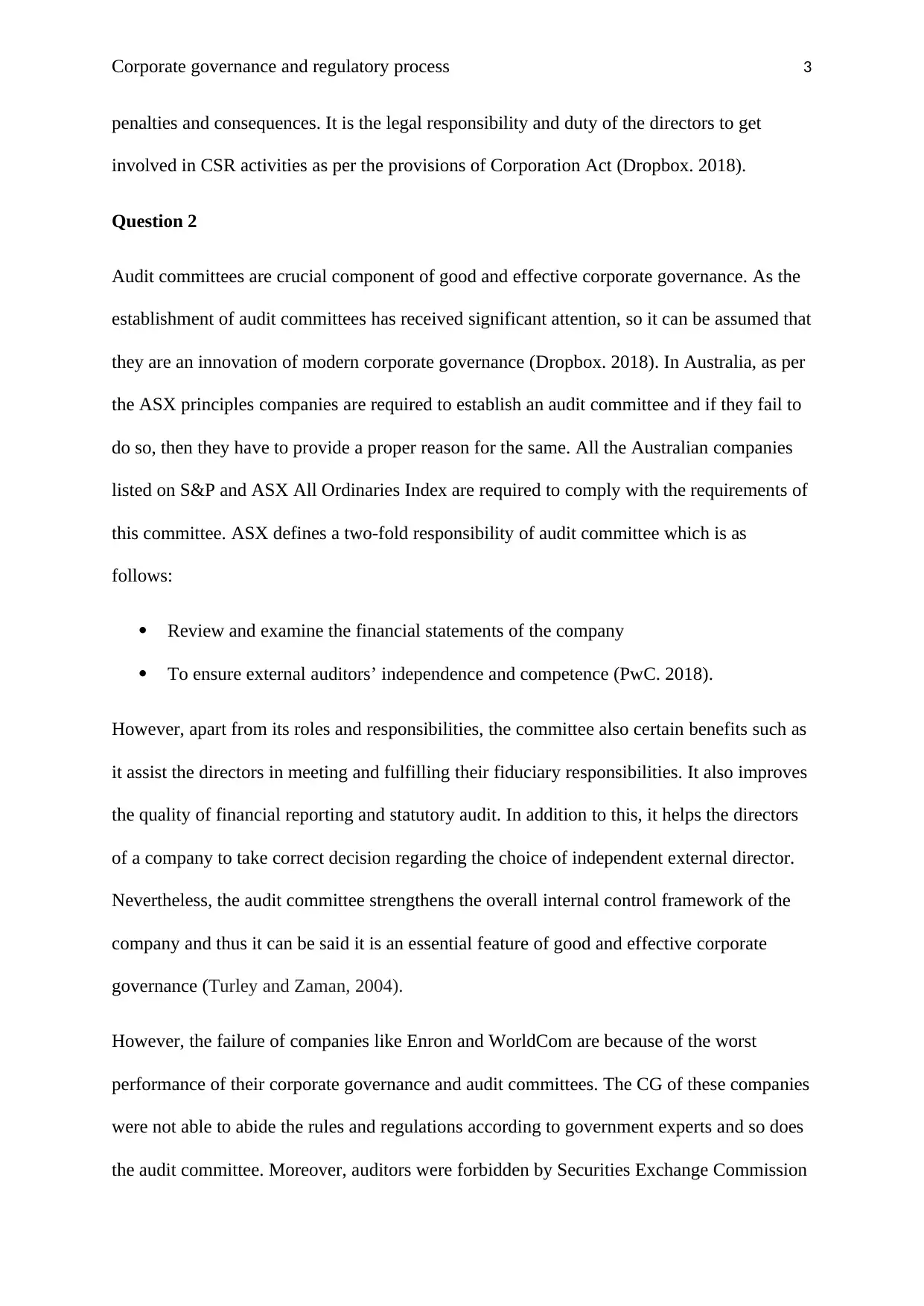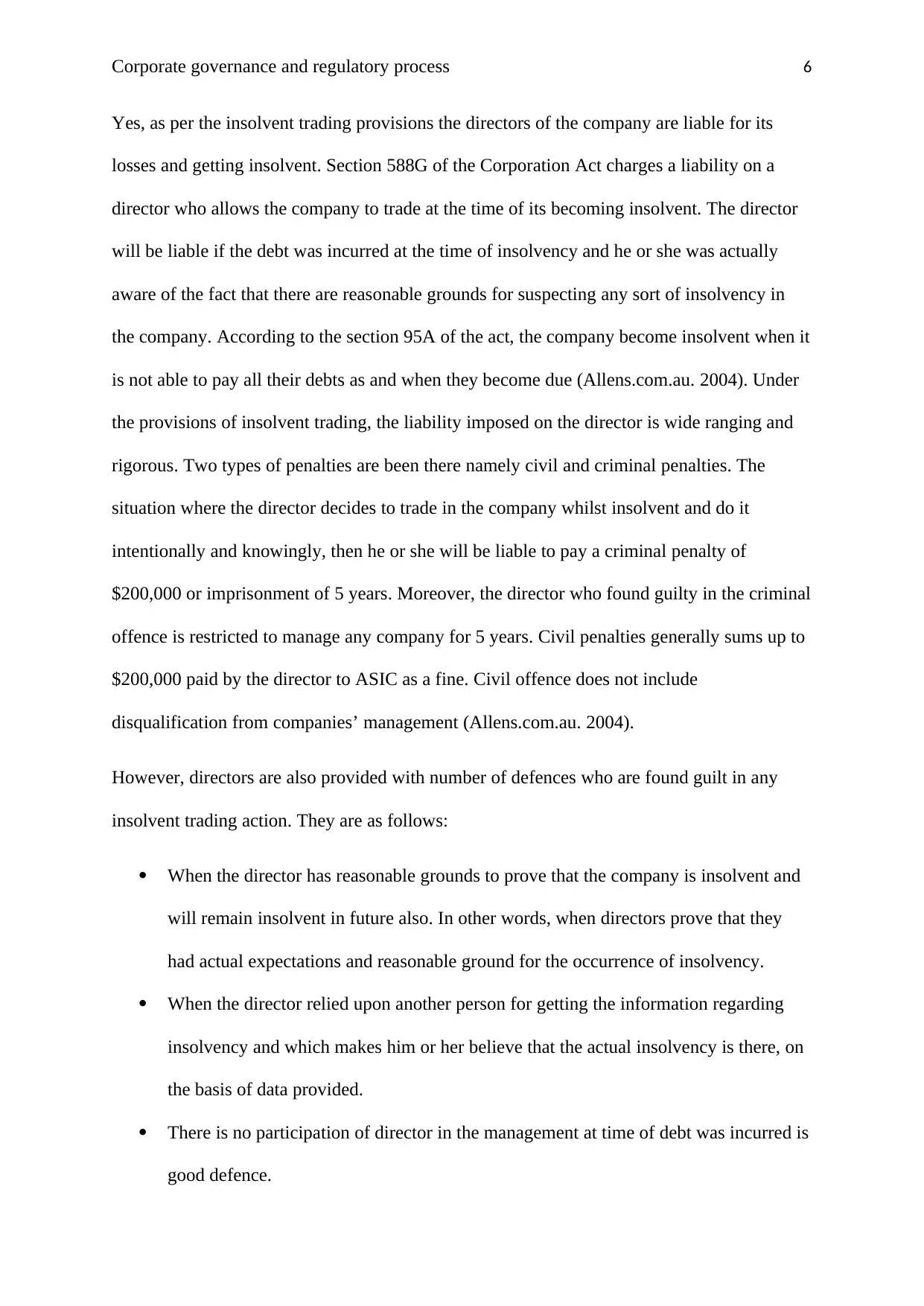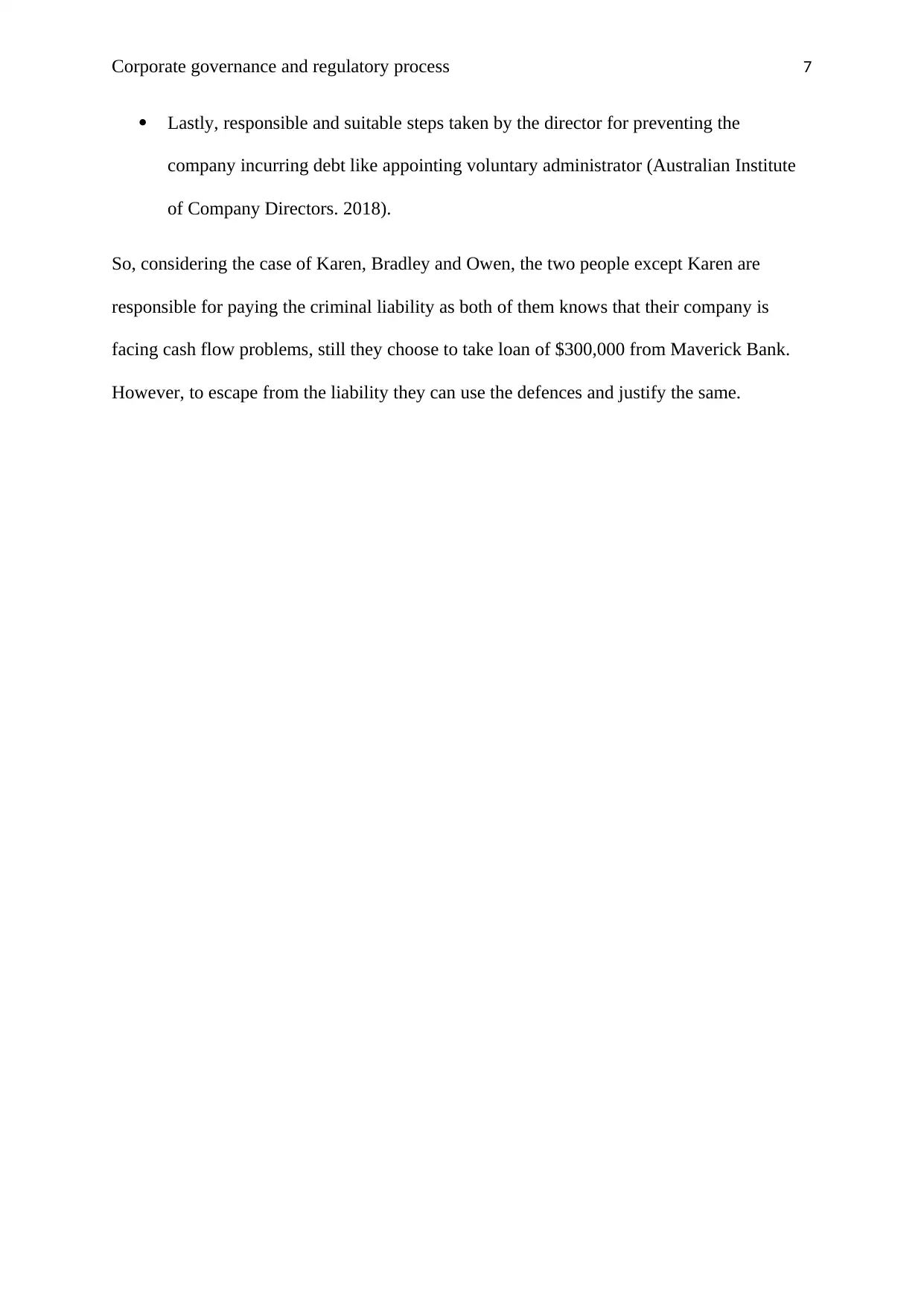Comprehensive Report on Corporate Governance and Regulatory Process
VerifiedAdded on 2023/06/11
|9
|1994
|126
Report
AI Summary
This report provides a comprehensive analysis of corporate governance and the regulatory process, focusing on key aspects such as corporate social responsibility (CSR), the role of audit committees, ASX Corporate Governance Council principles, and insolvent trading provisions. It examines the legal responsibilities of company directors concerning CSR activities under the Corporation Act 2001, highlighting the importance of balancing profit maximization with broader social and environmental considerations. The report further assesses the function and benefits of audit committees in enhancing corporate governance and financial reporting quality, while also noting the failures of companies like Enron and WorldCom due to governance and audit committee shortcomings. An evaluation of the ASX Corporate Governance Council's principles, particularly those related to board structure and composition, is included, offering recommendations for establishing an effective board. Finally, the report discusses the liabilities of directors under insolvent trading provisions, including potential civil and criminal penalties, and outlines available defenses. The case of Karen, Bradley, and Owen is analyzed within this context, determining their potential responsibilities and liabilities.

RUNNING HEAD: CORPORATE GOVERNANCE AND REGULATORY PROCESS
Corporate Governance
Corporate Governance
Paraphrase This Document
Need a fresh take? Get an instant paraphrase of this document with our AI Paraphraser

Corporate governance and regulatory process 2
Question 1
Corporate social responsibility is basically a concept whereby organizations combine their
social and environmental concerns in their business and also in their communication with the
stakeholders. In addition to this, CSR is defined as an extended view of responsibilities that
arises from the obligations of corporate governance. Following are the dimensions involved
in CSR:
A responsibility towards society and environment.
A commitment towards to environmental and social reporting.
Commitment given to employees.
Focusing on improving the stakeholder relation.
The directors of the company has several statutory legal responsibilities with respect to CSR
activities. Under common law, they have a general obligation of performing in the best
interest of the company. In other words they are responsible to take care of the financial well-
being of their stakeholders. However they are also liable to perform some statutory regulatory
activities for conducting the affairs of the business. In relation with CSR, section 180 and 181
of the Corporation Act 2001 are the two most relevant sections. Under these sections,
directors have some limitations in committing company resources to activities of CSR. Also
the directors should not fixate the profit maximizing activities in short term for the purpose of
excluding wider CSR considerations. Moreover, they do not have discretion in respect of the
judgements taken on behalf of the company (Dropbox. 2018).
Yes, there is a legal justification for the directors to engage in CSR activities. Fulfilling the
corporate social responsibility is one of the legal regulatory requirement which is to be
fulfilled by the companies. Complying with the CSR activities is required as per the
provisions of Corporation Act 2001 and non-compliance may lead to several types of
Question 1
Corporate social responsibility is basically a concept whereby organizations combine their
social and environmental concerns in their business and also in their communication with the
stakeholders. In addition to this, CSR is defined as an extended view of responsibilities that
arises from the obligations of corporate governance. Following are the dimensions involved
in CSR:
A responsibility towards society and environment.
A commitment towards to environmental and social reporting.
Commitment given to employees.
Focusing on improving the stakeholder relation.
The directors of the company has several statutory legal responsibilities with respect to CSR
activities. Under common law, they have a general obligation of performing in the best
interest of the company. In other words they are responsible to take care of the financial well-
being of their stakeholders. However they are also liable to perform some statutory regulatory
activities for conducting the affairs of the business. In relation with CSR, section 180 and 181
of the Corporation Act 2001 are the two most relevant sections. Under these sections,
directors have some limitations in committing company resources to activities of CSR. Also
the directors should not fixate the profit maximizing activities in short term for the purpose of
excluding wider CSR considerations. Moreover, they do not have discretion in respect of the
judgements taken on behalf of the company (Dropbox. 2018).
Yes, there is a legal justification for the directors to engage in CSR activities. Fulfilling the
corporate social responsibility is one of the legal regulatory requirement which is to be
fulfilled by the companies. Complying with the CSR activities is required as per the
provisions of Corporation Act 2001 and non-compliance may lead to several types of

Corporate governance and regulatory process 3
penalties and consequences. It is the legal responsibility and duty of the directors to get
involved in CSR activities as per the provisions of Corporation Act (Dropbox. 2018).
Question 2
Audit committees are crucial component of good and effective corporate governance. As the
establishment of audit committees has received significant attention, so it can be assumed that
they are an innovation of modern corporate governance (Dropbox. 2018). In Australia, as per
the ASX principles companies are required to establish an audit committee and if they fail to
do so, then they have to provide a proper reason for the same. All the Australian companies
listed on S&P and ASX All Ordinaries Index are required to comply with the requirements of
this committee. ASX defines a two-fold responsibility of audit committee which is as
follows:
Review and examine the financial statements of the company
To ensure external auditors’ independence and competence (PwC. 2018).
However, apart from its roles and responsibilities, the committee also certain benefits such as
it assist the directors in meeting and fulfilling their fiduciary responsibilities. It also improves
the quality of financial reporting and statutory audit. In addition to this, it helps the directors
of a company to take correct decision regarding the choice of independent external director.
Nevertheless, the audit committee strengthens the overall internal control framework of the
company and thus it can be said it is an essential feature of good and effective corporate
governance (Turley and Zaman, 2004).
However, the failure of companies like Enron and WorldCom are because of the worst
performance of their corporate governance and audit committees. The CG of these companies
were not able to abide the rules and regulations according to government experts and so does
the audit committee. Moreover, auditors were forbidden by Securities Exchange Commission
penalties and consequences. It is the legal responsibility and duty of the directors to get
involved in CSR activities as per the provisions of Corporation Act (Dropbox. 2018).
Question 2
Audit committees are crucial component of good and effective corporate governance. As the
establishment of audit committees has received significant attention, so it can be assumed that
they are an innovation of modern corporate governance (Dropbox. 2018). In Australia, as per
the ASX principles companies are required to establish an audit committee and if they fail to
do so, then they have to provide a proper reason for the same. All the Australian companies
listed on S&P and ASX All Ordinaries Index are required to comply with the requirements of
this committee. ASX defines a two-fold responsibility of audit committee which is as
follows:
Review and examine the financial statements of the company
To ensure external auditors’ independence and competence (PwC. 2018).
However, apart from its roles and responsibilities, the committee also certain benefits such as
it assist the directors in meeting and fulfilling their fiduciary responsibilities. It also improves
the quality of financial reporting and statutory audit. In addition to this, it helps the directors
of a company to take correct decision regarding the choice of independent external director.
Nevertheless, the audit committee strengthens the overall internal control framework of the
company and thus it can be said it is an essential feature of good and effective corporate
governance (Turley and Zaman, 2004).
However, the failure of companies like Enron and WorldCom are because of the worst
performance of their corporate governance and audit committees. The CG of these companies
were not able to abide the rules and regulations according to government experts and so does
the audit committee. Moreover, auditors were forbidden by Securities Exchange Commission
⊘ This is a preview!⊘
Do you want full access?
Subscribe today to unlock all pages.

Trusted by 1+ million students worldwide

Corporate governance and regulatory process 4
from owning stock in client’s company. Furthermore, the rules followed by the committee
were not able to accomplish and meet the desired objectives and goals. This is the reason for
such big failures. Therefore, it can be said that if proper control and right direction is been
provided to the audit committees, they will surely improve the performance and position of
the company. Though for Enron and WorldCom they are the reason for failure but proper
guidance may lead to a successful establishment of audit committees (Bloomberg.com.
2018).
Question 3
ASX Corporate Governance Council has set some parameters or standards for the corporate
governance of Australian companies. The ASX CGC was established in 2002 and it aimed at
producing the best practice corporate governance principles and recommendations in order to
guide the listed companies so that they follow standards of corporate governance. The ASX
CGC has eight principles which are to be followed by each and every entity. Among those,
the second principle deals with the structure of board of directors (Dropbox. 2018).
According to this principle, a listed company should have an appropriate size, composition,
skills and commitments of board. As far as the member of ‘I Design’ are concerned, for
becoming the board of directors, they have to fulfil certain requirements. As per ASX CGC
principles,
An effective board must be establish which has competence to deal with current and
emerging issues.
The board which can effectively review the performance of management and can
make an independent judgement.
from owning stock in client’s company. Furthermore, the rules followed by the committee
were not able to accomplish and meet the desired objectives and goals. This is the reason for
such big failures. Therefore, it can be said that if proper control and right direction is been
provided to the audit committees, they will surely improve the performance and position of
the company. Though for Enron and WorldCom they are the reason for failure but proper
guidance may lead to a successful establishment of audit committees (Bloomberg.com.
2018).
Question 3
ASX Corporate Governance Council has set some parameters or standards for the corporate
governance of Australian companies. The ASX CGC was established in 2002 and it aimed at
producing the best practice corporate governance principles and recommendations in order to
guide the listed companies so that they follow standards of corporate governance. The ASX
CGC has eight principles which are to be followed by each and every entity. Among those,
the second principle deals with the structure of board of directors (Dropbox. 2018).
According to this principle, a listed company should have an appropriate size, composition,
skills and commitments of board. As far as the member of ‘I Design’ are concerned, for
becoming the board of directors, they have to fulfil certain requirements. As per ASX CGC
principles,
An effective board must be establish which has competence to deal with current and
emerging issues.
The board which can effectively review the performance of management and can
make an independent judgement.
Paraphrase This Document
Need a fresh take? Get an instant paraphrase of this document with our AI Paraphraser

Corporate governance and regulatory process 5
As per the principle, the board should be comprising of majority of independent
directors. Here, independent means that director should be free of any other business
and management that can materially interfere (Asx.com.au. 2003).
The board should have a chairperson who is an independent director and the leader of
the board. The person appointed as a chairperson must have sufficient and relevant
knowledge and must pursue competent skills in order to monitor the overall
functioning of board.
The CEO and chairperson cannot be the same person.
In addition to this, the board should also have a nomination committee which consist
of minimum three independent directors chaired by the chairperson.
The size and the composition of the board should be favourable so as to make
appropriate decisions with help of diverse skills and perspectives. The size must be
limited so that efficient decision making can be done.
Also if there are non-executive directors, then they should be appointed for a specific
period of time subject to ASX Listing rules and Corporation Act provisions
(Asx.com.au. 2010).
From looking the above rules, it is suggested to Peter and his friends that they should have a
professional composition of board of directors. As all of the six persons are expert in their
respective fields and seems to have less knowledge about the ASX principles and legislations.
So, in order to have appropriate composition, they should elect the competent and
knowledgeable persons as board of directors who can take care of the entire functioning of
the company.
Question 4
As per the principle, the board should be comprising of majority of independent
directors. Here, independent means that director should be free of any other business
and management that can materially interfere (Asx.com.au. 2003).
The board should have a chairperson who is an independent director and the leader of
the board. The person appointed as a chairperson must have sufficient and relevant
knowledge and must pursue competent skills in order to monitor the overall
functioning of board.
The CEO and chairperson cannot be the same person.
In addition to this, the board should also have a nomination committee which consist
of minimum three independent directors chaired by the chairperson.
The size and the composition of the board should be favourable so as to make
appropriate decisions with help of diverse skills and perspectives. The size must be
limited so that efficient decision making can be done.
Also if there are non-executive directors, then they should be appointed for a specific
period of time subject to ASX Listing rules and Corporation Act provisions
(Asx.com.au. 2010).
From looking the above rules, it is suggested to Peter and his friends that they should have a
professional composition of board of directors. As all of the six persons are expert in their
respective fields and seems to have less knowledge about the ASX principles and legislations.
So, in order to have appropriate composition, they should elect the competent and
knowledgeable persons as board of directors who can take care of the entire functioning of
the company.
Question 4

Corporate governance and regulatory process 6
Yes, as per the insolvent trading provisions the directors of the company are liable for its
losses and getting insolvent. Section 588G of the Corporation Act charges a liability on a
director who allows the company to trade at the time of its becoming insolvent. The director
will be liable if the debt was incurred at the time of insolvency and he or she was actually
aware of the fact that there are reasonable grounds for suspecting any sort of insolvency in
the company. According to the section 95A of the act, the company become insolvent when it
is not able to pay all their debts as and when they become due (Allens.com.au. 2004). Under
the provisions of insolvent trading, the liability imposed on the director is wide ranging and
rigorous. Two types of penalties are been there namely civil and criminal penalties. The
situation where the director decides to trade in the company whilst insolvent and do it
intentionally and knowingly, then he or she will be liable to pay a criminal penalty of
$200,000 or imprisonment of 5 years. Moreover, the director who found guilty in the criminal
offence is restricted to manage any company for 5 years. Civil penalties generally sums up to
$200,000 paid by the director to ASIC as a fine. Civil offence does not include
disqualification from companies’ management (Allens.com.au. 2004).
However, directors are also provided with number of defences who are found guilt in any
insolvent trading action. They are as follows:
When the director has reasonable grounds to prove that the company is insolvent and
will remain insolvent in future also. In other words, when directors prove that they
had actual expectations and reasonable ground for the occurrence of insolvency.
When the director relied upon another person for getting the information regarding
insolvency and which makes him or her believe that the actual insolvency is there, on
the basis of data provided.
There is no participation of director in the management at time of debt was incurred is
good defence.
Yes, as per the insolvent trading provisions the directors of the company are liable for its
losses and getting insolvent. Section 588G of the Corporation Act charges a liability on a
director who allows the company to trade at the time of its becoming insolvent. The director
will be liable if the debt was incurred at the time of insolvency and he or she was actually
aware of the fact that there are reasonable grounds for suspecting any sort of insolvency in
the company. According to the section 95A of the act, the company become insolvent when it
is not able to pay all their debts as and when they become due (Allens.com.au. 2004). Under
the provisions of insolvent trading, the liability imposed on the director is wide ranging and
rigorous. Two types of penalties are been there namely civil and criminal penalties. The
situation where the director decides to trade in the company whilst insolvent and do it
intentionally and knowingly, then he or she will be liable to pay a criminal penalty of
$200,000 or imprisonment of 5 years. Moreover, the director who found guilty in the criminal
offence is restricted to manage any company for 5 years. Civil penalties generally sums up to
$200,000 paid by the director to ASIC as a fine. Civil offence does not include
disqualification from companies’ management (Allens.com.au. 2004).
However, directors are also provided with number of defences who are found guilt in any
insolvent trading action. They are as follows:
When the director has reasonable grounds to prove that the company is insolvent and
will remain insolvent in future also. In other words, when directors prove that they
had actual expectations and reasonable ground for the occurrence of insolvency.
When the director relied upon another person for getting the information regarding
insolvency and which makes him or her believe that the actual insolvency is there, on
the basis of data provided.
There is no participation of director in the management at time of debt was incurred is
good defence.
⊘ This is a preview!⊘
Do you want full access?
Subscribe today to unlock all pages.

Trusted by 1+ million students worldwide

Corporate governance and regulatory process 7
Lastly, responsible and suitable steps taken by the director for preventing the
company incurring debt like appointing voluntary administrator (Australian Institute
of Company Directors. 2018).
So, considering the case of Karen, Bradley and Owen, the two people except Karen are
responsible for paying the criminal liability as both of them knows that their company is
facing cash flow problems, still they choose to take loan of $300,000 from Maverick Bank.
However, to escape from the liability they can use the defences and justify the same.
Lastly, responsible and suitable steps taken by the director for preventing the
company incurring debt like appointing voluntary administrator (Australian Institute
of Company Directors. 2018).
So, considering the case of Karen, Bradley and Owen, the two people except Karen are
responsible for paying the criminal liability as both of them knows that their company is
facing cash flow problems, still they choose to take loan of $300,000 from Maverick Bank.
However, to escape from the liability they can use the defences and justify the same.
Paraphrase This Document
Need a fresh take? Get an instant paraphrase of this document with our AI Paraphraser

Corporate governance and regulatory process 8
References
Allens.com.au. (2004). DIRECTORS' DUTIES – THE INSOLVENT TRADING ISSUES
FROM A LAWYER’S PERSPECTIVE. [Online] Available at:
https://www.allens.com.au/pubs/pdf/insol/pap18feb04.pdf [Accessed 19 June 2018].
Asx.com.au. (2003). ASX Corporate Governance Council. [Online] Available at:
https://www.asx.com.au/documents/asx-compliance/principles-and-recommendations-march-
2003.pdf [Accessed 19 June 2018].
Asx.com.au. (2010). Corporate Governance Principles and Recommendations with 2010
Amendments. [Online] Available at:
https://www.asx.com.au/documents/asx-compliance/cg_principles_recommendations_with_2
010_amendments.pdf [Accessed 19 June 2018].
Australian Institute of Company Directors. (2018). Insolvent trading Duties of directors.
[Online] Available at: https://aicd.companydirectors.com.au/~/media/cd2/resources/director-
resources/director-tools/pdf/05446-6-3-duties-directors_insolvent-trading_a4-web.ashx
[Accessed 19 June 2018].
Bloomberg.com. (2018). Commentary: How Governance Rules Failed at Enron. [Online]
Available at: https://www.bloomberg.com/news/articles/2002-01-20/commentary-how-
governance-rules-failed-at-enron [Accessed 19 June 2018].
Dropbox. (2018). Weekly Slides. [Online] Available at:
https://www.dropbox.com/sh/dwaacemyzn6alc7/AAA432sIHIRCWabcuto0kFtKa?dl=0
[Accessed 19 June 2018].
References
Allens.com.au. (2004). DIRECTORS' DUTIES – THE INSOLVENT TRADING ISSUES
FROM A LAWYER’S PERSPECTIVE. [Online] Available at:
https://www.allens.com.au/pubs/pdf/insol/pap18feb04.pdf [Accessed 19 June 2018].
Asx.com.au. (2003). ASX Corporate Governance Council. [Online] Available at:
https://www.asx.com.au/documents/asx-compliance/principles-and-recommendations-march-
2003.pdf [Accessed 19 June 2018].
Asx.com.au. (2010). Corporate Governance Principles and Recommendations with 2010
Amendments. [Online] Available at:
https://www.asx.com.au/documents/asx-compliance/cg_principles_recommendations_with_2
010_amendments.pdf [Accessed 19 June 2018].
Australian Institute of Company Directors. (2018). Insolvent trading Duties of directors.
[Online] Available at: https://aicd.companydirectors.com.au/~/media/cd2/resources/director-
resources/director-tools/pdf/05446-6-3-duties-directors_insolvent-trading_a4-web.ashx
[Accessed 19 June 2018].
Bloomberg.com. (2018). Commentary: How Governance Rules Failed at Enron. [Online]
Available at: https://www.bloomberg.com/news/articles/2002-01-20/commentary-how-
governance-rules-failed-at-enron [Accessed 19 June 2018].
Dropbox. (2018). Weekly Slides. [Online] Available at:
https://www.dropbox.com/sh/dwaacemyzn6alc7/AAA432sIHIRCWabcuto0kFtKa?dl=0
[Accessed 19 June 2018].

Corporate governance and regulatory process 9
PwC. (2018). Role of the audit committee. [Online] Available at:
https://www.pwc.com/gx/en/services/audit-assurance/publications/audit-committee-role.html
[Accessed 19 June 2018].
Turley, S. and Zaman, M. (2004). The corporate governance effects of audit
committees. Journal of management and governance, 8(3), pp.305-332.
PwC. (2018). Role of the audit committee. [Online] Available at:
https://www.pwc.com/gx/en/services/audit-assurance/publications/audit-committee-role.html
[Accessed 19 June 2018].
Turley, S. and Zaman, M. (2004). The corporate governance effects of audit
committees. Journal of management and governance, 8(3), pp.305-332.
⊘ This is a preview!⊘
Do you want full access?
Subscribe today to unlock all pages.

Trusted by 1+ million students worldwide
1 out of 9
Related Documents
Your All-in-One AI-Powered Toolkit for Academic Success.
+13062052269
info@desklib.com
Available 24*7 on WhatsApp / Email
![[object Object]](/_next/static/media/star-bottom.7253800d.svg)
Unlock your academic potential
Copyright © 2020–2025 A2Z Services. All Rights Reserved. Developed and managed by ZUCOL.




